By Elvia Verdugo / El Inde
On the ground floor of her rustic red brick building, Rosanne Placencia-Knepper carefully adorns her wooden kitchen island with prepped ingredients for this week’s dish–a stuffed beef curry roti. This week’s ingredients include flour, salt, local grass-fed beef and what she calls “the holy trinity of curry,” a mixture of garlic, ginger and chilies.
It’s nearly 1 p.m. on a frosty Sunday afternoon in February in the Mott Haven neighborhood in the Bronx, which can mean only one thing for Placencia-Knepper; it’s time to live stream this week’s cooking session and help her 177 total viewers step back from the rush of the fast-paced New York City lifestyle and toward their dinner tables.
Above her hangs a cell phone attached to a mic stand, allowing her viewers to get crisp audio from the stream. Her deep brunette hair is pulled back and her tan canvas apron that reads “Cumpanis,” the Latin word for “with bread,” is neatly covering her black long sleeve shirt that’s rolled up to her elbows–she is ready to cook. She checks the phone’s microphone volume one last time before she starts.
As a self-proclaimed introvert, Placencia-Knepper finds herself adjusting to life on camera. As her live stream kicks off, she rolls her shoulders to help calm her nerves and with one deep breath, she begins.
“Hi, Instagram! Hola!” she excitedly says while smiling into the camera.
As she bounces around the white-tiled backsplash in her kitchen, grabbing utensils or turning on her gas stove, her golden-tan complexion glows underneath the bright kitchen lights. Her passion for cooking radiates from within.
The 39-year-old Dominicana is the CEO and founder of Cumpanis NYC, a South Bronx-based company focusing on building a better community through food and wellness. Her weekly live streams are just one way that Placencia-Knepper reaches out to area residents to teach them how to cook with ingredients they have on-hand, the importance of avoiding processed foods with unnecessary ingredients and how to incorporate healthier foods into their everyday lives. Despite utilizing a mostly virtual platform these days, Placencia-Knepper doesn’t hold back from sharing her passion for the power of food and wellness with her audience.
Before she founded Cumpanis in 2014, Placencia-Knepper worked in the juvenile justice field. She worked closely with the NYC Department of Probation’s initiative, Credible Messengers, where she composed curriculums for mentors working with youth involved in the juvenile justice system.
After years of this work, Placencia-Knepper decided to branch out into her community outreach by incorporating food education into the curriculum. She co-founded the South Bronx Farmers Market in 2014 to help bring healthy, affordable produce to her community and eventually held cooking workshops with Food Corps, a nonprofit organization dedicated to helping kids connect with healthier food.
After witnessing others’ excitement to eat healthier and their eagerness to learn, she launched Cumpanis from the kitchen of her home. Her goal was simple–help reconnect New York City communities through real food and boost confidence within the community to shop, prepare and cook local healthy ingredients.
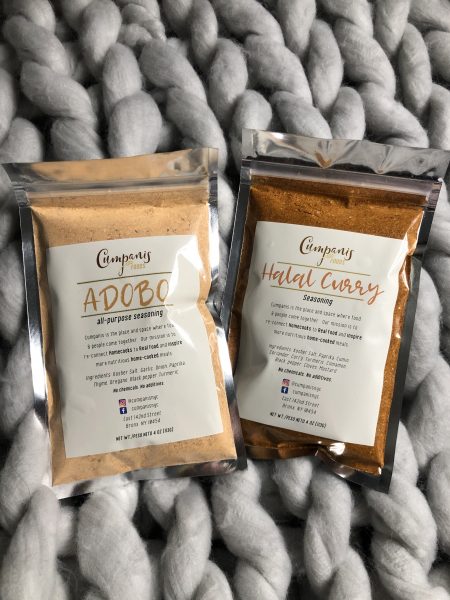
Photo by Elvia Verdugo/El Inde.
The Chocolate Chip Cookie That Changed Everything
Placencia-Knepper started cooking her first meals at 11. She was born to Dominican parents in the Bronx in the early 1980s and after her father passed away when she was two, her mother moved with Placencia-Knepper and two siblings to the Dominican Republic. Her passion for cooking was heavily influenced by being raised in both the Bronx and the Dominican Republic.
Growing up in the Dominican Republic, she would climb voluptuous trees to fetch ripe, juicy mangos to share with her friends. But when she moved back to the Bronx at the age of nine, her access to fresh fruits disappeared. She found herself spending the day consuming endless packs of Oreos and watching Tom & Jerry cartoons. She calls the transition from her life in the D.R. to the U.S. as a “huge loss” as she went from having readily available fresh food and participating in physical activities outdoors to sitting idly in front of a TV screen.
“We grew up eating together and cooking meals from scratch. Food in the Dominican Republic is different. We ate chickens from the backyard. We had access to a lot of fresh food and we ate all of our meals together, but we never did any kind of baking,” she says.
Placencia-Knepper says she’s always had a sweet tooth and often found herself spending her lunch money on sweets and chocolates at local markets and bodegas. Because her childhood consisted of cooking traditional savory Dominican dishes, such as a stewed chicken dish called Pollo al Caldero, she didn’t know it was possible to make warm and delicious baked goods at home.
Until one day in middle school when her teacher, Ms. Finn, strolled into the classroom with freshly baked chocolate chip cookies. The strong aroma of vanilla and chocolate infiltrated the classroom, leaving Placencia-Knepper floored at the perfectly golden homemade cookies her teacher made with her own two hands.
“So the cookie was kind of like what opened my mind to the idea that all these big goods and all these processed foods, which I love, like actually were possible [to make] at home,” she says while reminiscing about that day in middle school.
Inspired by the homemade chocolate chip cookies, Placencia-Knepper learned to make her own baked goods throughout her teenage years. However, she began to develop health issues due to high sugar consumption. She found herself constantly feeling sick and after numerous visits to her doctor, she was diagnosed with Polycystic Ovary Syndrome, a hormonal disorder where it’s critical to avoid sugary foods. In an attempt to fix her body, she began to approach food more holistically by learning about the impact of processed foods in our bodies.
“I started to understand that food could heal you, but it could also hurt you or rather it could hurt you, but it could also heal you,” she expresses confidently.
She shares the “cookie story” with those around her in hopes of bringing awareness to how health directly correlates with diet. She calls the story her “aha moment.”
“So the cookie got me started cooking. The cookie also got me sick,” she laughs. “We need to empower people to know that food doesn’t come from the store and it doesn’t have to be in a box or in a bag. It can be real fresh ingredients. And it makes all the difference in our health.”
Breaking Bread in the Bronx
As she continues with her Sunday livestream, Placencia-Knepper combines three cups of flour with one and a half teaspoons of salt in a large metal mixing bowl and mixes the ingredients by hand. The dry ingredients slip through her hand, covering the perfectly fitted silver ring on her finger. She slowly pours in a little over a cup of water into the mixture, combining the wet and dry ingredients with a wooden spoon. As the ingredients transform into a sticky dough, she transfers the mixture to her dark wooden cutting board lightly covered in flour and begins to knead the dough.
She presses down on the dough with the palm of her hand as she folds and rotates the dough until she makes a complete 360, repeating the process until a smooth ball of dough forms beneath her hands. “This is kneading,” she explains to her viewers. “Fold, press, rotate.”
She divides the dough into 16 pieces, places them on a large silver sheet pan and slowly pours olive oil from a small silver watering can onto the tops of the dough. She lets the dough rest, soaking up the much-needed fat from the oil before she stretches out the dough to stuff with the beef curry.
Bread is one of Placencia-Knepper’s favorite foods to whip up in the kitchen. Whether it’s bread, roti, naan or anything else with yeast, she calls her fascination with dough a “love affair.” She explains how creating dough is a magical process as she gets to witness the dough come alive between her hands.
“When you’re dealing with dough, there’s this relationship, you know, that you have with it, you kind of have to listen to it. You kind of have to honor it. And like, I really do feel like there’s a bacterial or a microbial exchange that happens between your hands and the dough that I think we have yet to figure out. But I’m pretty sure it’s there and I think it makes the food nutritious and better,” she describes while sitting comfortably in her office.
Bread is the common thread that runs through Placencia-Knepper’s life, allowing her to make relationships with the dough itself and her community members through Cumpanis’ educational program and community cooking classes she likes to call “Breaking Bread.”
Creating Community One Class at a Time
Currently, the Bronx faces a health crisis with the lack of fresh food available to the community. According to the New York City Food Policy Center, adult obesity is 10% higher in the South Bronx than in other places in New York City and as of 2017, one in five South Bronx residents has been diagnosed with diabetes.
Placencia-Knepper believes the health crisis is linked to the inaccessibility of fresh produce. She recalls seeing withering chilies, milk on the brink of expiring and the difficulty of finding fresh greens at supermarkets in the Bronx. She believes that supermarkets purchase items about to expire to sell them at a lower price to individuals.
“You know, I think that people are under the impression that they choose what they want to eat. And I’m always saying like, ‘you’re not choosing what you want to eat. You have very limited options around you and the food is being chosen for you,’” she says.
Placencia-Knepper uses her cooking workshops to bring awareness to how inaccessibility can affect health and the sense of community. She held her first cooking workshop in the Bronx at Concrete Plant Park in 2014 after completing a year of service with FoodCorps. She planned to make one of her favorite recipes, Three Sisters Chili, a hearty chili with corn, beans and squash. Prior to the event, she handed out fliers to the community hoping that someone would stop by to learn about healthier eating and share a meal. She was astonished at the crowd that drew around her table at the park.
Reflecting back on the crowd, she refers to them as “the most interesting crowd of people.” The group included an elderly woman accompanied by her daughter who had Alzheimer’s, a child on roller skates and two men from Africa, or as she describes it, “just Bronx people.”
“We created a community with complete strangers who were all cooking and then we set the table and sat together and it was like, ‘OK, this is my work. This is my work,’” Placencia-Knepper says.
Placencia-Knepper worked with her now close friend, Jeannette Bocanegra, on a cooking workshop for individuals in the juvenile justice system. Bocanegra, who refers to Placencia-Knepper as the “Latina Marilyn Monroe,” believes that Placencia-Knepper is an inspiration to young people by “bringing fresh air to thinking differently that it’s not OK to deal with food injustices.” With prior experience of working in the justice system, Placencia-Knepper had no problem jumping back into that world to help those individuals find a sense of community.
Most of Cumpanis’ cooking workshops have been contracted by the Horizon Juvenile Center in the Bronx. The juvenile center is only a few blocks away from Placencia-Knepper’s building and on the days she did workshops there, she would pack up two big clear plastic bins, fill them up with utensils and the pre-prepped ingredients and roll them to the center. Upon her arrival at the center, she places a “wash your hands” sign on the sink, hands out aprons and distributes laminated instruction sheets for the day’s dish, such as Mediterranean chicken, to the participants. When they get along, she lets them decide which part of the dish they want to handle. If they don’t, she will assign tasks to each individual.
“You have the tomato, you have the lemon, you have the cilantro,” she would say to the participants.
As they finished cooking together as a group, they set the table with a tablecloth, centerpiece and reusable plastic plates Placencia-Knepper brought with her to help the young men “feel human and not like just a number or a problem.” As they sat down and enjoyed a meal together, one of the participants spoke up and described how eating together at a table felt like home.
“And that was just like,” she pauses and takes a deep breath. “Cause it’s not home at a detention center, but the fact that I can bring food and set a space here that makes you feel at home, like tugs at my heart,” she finishes while smiling.
#WellnessInTheHood
On that same frosty Sunday in her Mott Haven home, she begins creating the beef curry mixture in her bright orange skillet, she adds the “holy trinity of curry,” ginger, garlic and chilies. The ingredients hit the hot oil and begin to sizzle and dance around the pan.
“And that’s my favorite sound in the whole wide world,” she says as she tosses half of a diced onion into the pan.
As she adds in a heaping amount of one of Cumpanis’ signature spice mixes, halal curry, she stirs the mixture with her favorite utensil: a wooden spoon with a slanted edge and a hole in the middle. A spoon that she has had for as long as she can remember and even considered getting tattooed on her at one point.
Once the garlic becomes fragrant, she mixes in grass-fed beef, cubed potatoes, a small amount of local homemade ketchup and some peas to finish the curry. She bends down and grabs a cherry red pot from underneath her kitchen cabinet and proceeds to carefully scoop the beef curry into the pot to let the mixture cool down before handling it. Once the curry has cooled, she is able to stuff the mixture into the resting roti dough to create something healthy and delicious.
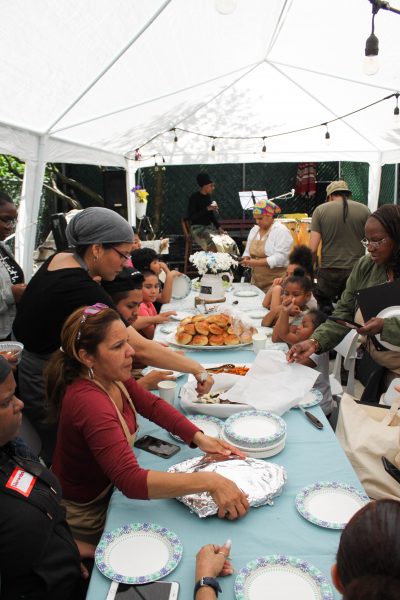
May 20, 2019. Photo courtesy of Lucas Janos of Studio DBC.
Placencia-Knepper’s mission of promoting the power of health and food in her community, or as she likes to call it, “wellness in the hood,” has created a small Cumpanis family within the Bronx. Her close-knit group of friends, including Mercedes Reyes and Rudy Rimpel, have assisted Placencia-Knepper with launching her breaking bread workshops. When Placencia-Knepper converted her in-person cooking workshops into a virtual format due to COVID-19, Reyes, a past participant in the workshops, helped hand-deliver kitchen kits of utensils and other cooking essentials, such as pans, oil and “everything you could need,” to families participating in the virtual workshops, Reyes explains.
Rimpel helped Placencia-Knepper launch her first 6-week cooking course when Cumpanis began. He says there’s no better person to speak up about food injustice within the Bronx because she is extremely organized and “200% invested.” He describes Placencia-Knepper as “[coming] across as a light rain, but she’s a thunderstorm.”
Because of Placencia-Knepper’s workshops, Rimpel has begun to look into buying fresh vegetables, such as leafy greens and good fruits from the supermarkets. He explains how New York City has some of the highest rates of diabetes, obesity and hypertension and the work that Placencia-Knepper is doing is vital because people will begin to look into those issues and how to eat healthier.
“I wish more people were doing that,” he says.
Reyes shares similar sentiments with Rimpel by explaining how some people don’t know how to take care of themselves. But by participating in Cumpanis’ workshops, people can learn basic healthy recipes that could make a huge difference in their lifestyle, like lowering their cholesterol.
Placencia-Knepper believes that educating people about food and wellness gives them the power to not only better themselves but the community. She shows them that you don’t have to settle for poor quality ingredients because you don’t live on the wealthy side of the city. You can create healthy home-cooked meals that promote wellness, even in the hood.
Cumpanis Now, Cumpanis Forever
Placencia-Knepper says that “Cumpanis began as a little seed in my heart in 2009.” Since officially becoming a limited liability company in 2014, her business has curated community cooking classes, educational workshops and cooking livestreams to help bring awareness to health and food in the Bronx.
She has also created two chemical and additive-free spice mixes that are available to purchase from her website or a few local shops in the Bronx. Her all-purpose adobo seasoning consists of dehydrated and ground-up garlic, onions, peppers and herbs. While her halal curry spice mix is inspired by New York City street carts and includes paprika, cumin, turmeric and other spices.
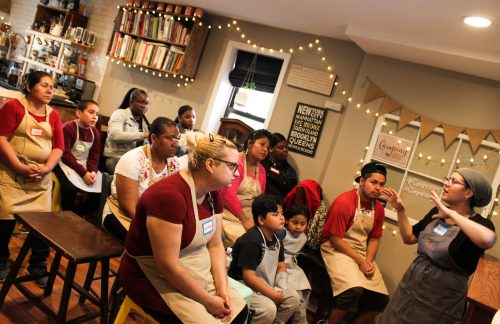
Photo courtesy of Lucas Janos of Studio DBC.
“She has the right ingredients for your olla [a cooking pot.] You put Cumpanis adobo in your olla and you don’t need Goya,” Bocanegra says while chuckling.
But Placencia-Knepper doesn’t want to stop at making her own spice mixes.
She is currently in the process of creating a nonprofit side to Cumpanis that will continue to allow her to educate more people in her New York City community. She hopes that by empowering and educating others, her community will be able to stand up and fight the “food system monster.”
“So if we start to create food systems that are local, that reflect the local community, the local resources that employ locally, then you start to dismantle that monster,” Placencia-Knepper explains.
Within the next 10 years, Placencia-Knepper hopes to create a small food-producing hub at Cumpanis. This hub will include selling her homemade spice mixes, selling other additive-free pantry items, sourcing local wheat and other produce while creating jobs within her community. But most importantly, she says it will not be dependent on the food system.
Those close to her say that they would love for her to have a large building for her cooking classes, compose books and even have her own television show. But for now, Placencia-Knepper’s work in the Bronx isn’t completed. In fact, it’s still getting started.
On that same icy Sunday afternoon in February, Placencia-Knepper’s live stream is nearing its end. As the beef curry finally cooled in the cherry red pot, it’s time to stretch out the roti dough. She gently dips her fingers into the leftover oil from the sheet pan and begins to tenderly stretch out the dough with her oiled fingertips. Once the dough is pulled into a thin circular shape, it’s ready to stuff.
She reaches into a kitchen drawer, pulls out an ice cream scoop and takes two large scoops of the beef curry from the pot. After placing the stuffing onto the dough, she spreads it out with her fingertips and begins to mold the mixture into a triangular shape. She then takes each side of the dough and gently layers it on top of the stuffing, creating a triangle of stuffed goodness.
There’s only one step left–cook the stuffed roti on the hot cast-iron flattop. She emphasizes the importance of cooking the rotis on all sides to ensure an even golden crust. The rotis turn from a pale cream color to a deep golden brown as she pulls one from the flat top to cut it open to show off the inside.
She opens up the roti, holds it up to the camera to show off the dark filling with specs of green from the peas and laughs with excitement. “Oh my God! You guys… beautiful,” she says.
Placencia-Knepper closes her Sunday stream by reminding her audience to join her next week as she plans to make fruit tarts with a special guest. She then smiles and waves goodbye to those watching.
“That’s the big thing,” she pauses. “Demystifying [food]… you could do it. There’s an inner cook in you and you have been separated because you have been relying on processed, convenient foods that make things easy, but it’s really taken you away from the experience of real ingredients. You could do it.”
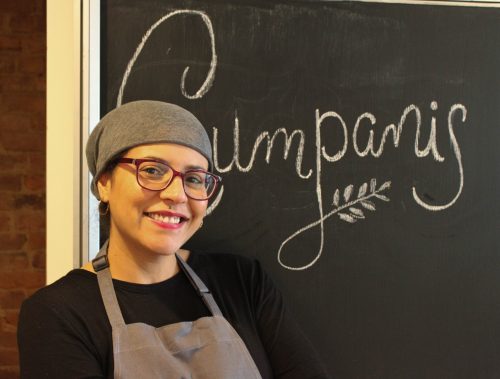
Photo courtesy of Lucas Janos of Studio DBC.
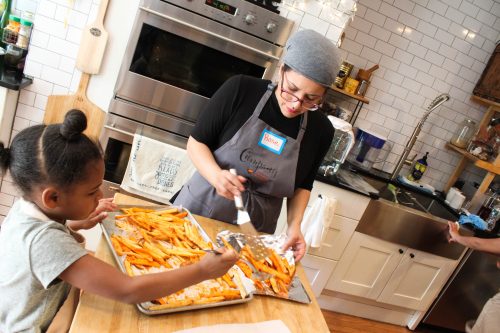
on May 20, 2019. Photo courtesy of Lucas Janos of Studio DBC.
